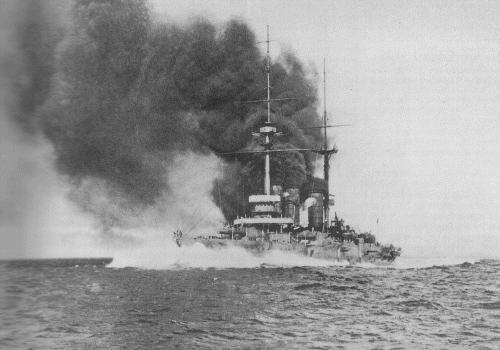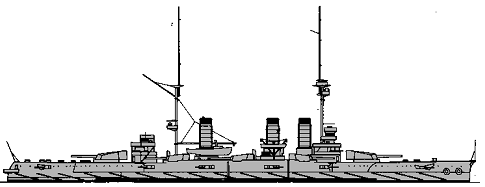
NAVYPEDIA
 Support the project with paypal
Support the project with paypal
Photo

Aki 1911
Ships
| Name | No | Yard No | Builder | Laid down | Launched | Comp | Fate |
|---|---|---|---|---|---|---|---|
| 安芸 [Aki] | Kure K K | 15.3.1906 | 15.4.1907 | 11.3.1911 | stricken 9.1923, sunk as target 2.9.1924 |
Technical data
| Displacement normal, t | 20100 |
|---|---|
| Displacement full, t | 21800 |
| Length, m | 146.9 wl 150.0 oa |
| Breadth, m | 25.5 |
| Draught, m | 8.40 |
| No of shafts | 2 |
| Machinery | 2 Curtis steam turbines, 15 Miyabara boilers |
| Power, h. p. | 24000 |
| Max speed, kts | 20 |
| Fuel, t | coal 3000 + oil 172 |
| Endurance, nm(kts) | |
| Armour, mm | belt: 229 - 102, deck: 51 with 76-mm slopes, 305mm gun barbettes: 234 - 178, 305mm gun turrets: 203 - 178, 254mm gun barbettes: 120, 254mm gun turrets: 120, casemates: 152, CT: 152 |
| Armament | 2 x 2 - 305/45 41-shiki, 6 x 2 - 254/45 41-shiki, 8 x 1 - 152/45 41-shiki, 12 x 1 - 76/40 41-shiki, 4 x 1 - 76/23 41-shiki, 5 - 450 TT (1 bow, 4 beam) |
| Complement | 931 |
Standard scale images

Aki 1911
Graphics
Project history
Satsuma and Aki were to have been the first Japanese all-big-gun battleships, but 254mm guns had to be substituted for single 305mm due to shortages in Japan. Thus the planned 12-305/45 (4x2, 4x1) were replaced by 4 305mm and 12 254mm (6x2). Both units were ordered from the two main Navy yards (Yokosuka and Kure) late in 1904, but Aki could not be laid down until her slip was vacated by the armoured cruiser Tsukuba. The delay allowed the Japanese Navy to decide to fit her with turbines (which were Curtis units built by the Fore River Yd in the United States), and to replace her 120mm secondary battery with 152mm guns. Aki also differed visually from her near sister. She had three unequally spaced funnels (the third further apart than the other two). By way of contrast, the next ship, the Kawachi, had her last two funnels closer together.
Satsuma made 18.95kts on 18,507ihp on trials; Aki 20.25kts on 27,740shp.
Ship protection
Thickness of main belt was 229mm between main gun barbettes decreasing to 127mm outside barbettes and to 102mm near ship ends. There was upper belt between main belt and casemate deck. Its thickness was 203mm between main gun barbettes decreasing fwd from fore barbette. Casemates were protected by 152mm armor. 51mm main deck connected with lower edge of main belt by 76mm slopes. 12`` turrets had 305mm faces and 203mm sides. CT had 305mm sides and 102mm roof.
Modernizations
1916 - 1917: - 8 x 1 - 76/40; + 2 x 1 - 76/40 3-shiki AA
Naval service
Aki was disarmed after the Washington conference, converted to target and sunk on manoeuvres 2.9.1924 by battlecruiser Kongo and battleship Hyuga.
 HOME
HOME FIGHTING SHIPS OF THE WORLD
FIGHTING SHIPS OF THE WORLD JAPAN
JAPAN CAPITAL SHIPS
CAPITAL SHIPS AKI battleship (1911)
AKI battleship (1911)
